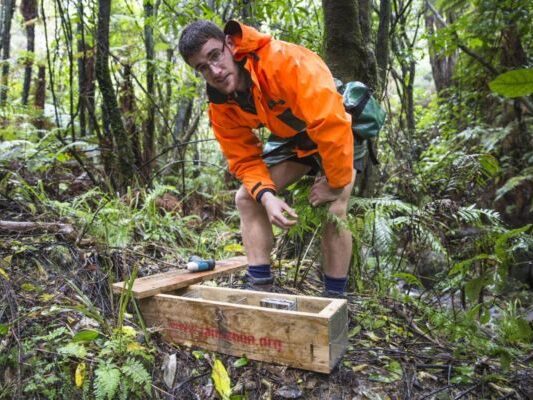by Robyn Janes.
It is the smell that often lets them know they have a body to deal with. Or the incessant buzzing of the wasps as they fly in and out of the wooden trap box.
“If it’s a real whiffy one you know it when you’re a couple of metres from the trap box. Most kills are fine to deal with but they can be a gooey, fluffy, bony mess which is pretty gross,” says DOC ranger Steve Holloway.
Steve and colleagues Bill Knox, John Whibley and Megan Bleakley are the Motueka based rangers responsible for checking the southern end of Project Janszoon’s stoat trapping network in the Abel Tasman National Park. The network, which covers 70% of the Park, currently has 3,000 traps and will soon be extended north of Totaranui thanks to new funding from Air New Zealand.
Three thousand traps equate to about 200km of trap lines to be walked every month. Each of the four rangers spend seven to eight days a month checking the trap network.

Over a year it is the equivalent of walking on SH1 from Cape Reinga to Bluff and then back to Oamaru.
It can be a tough, lonely job. The rangers work in tiger country, tramping up and down the trap lines through awkward bush terrain. In winter it can be a bit dismal walking around in the wet bush and in the peak of summer it is hot and dry with the sun reflecting off the granite.
“You can do half a day in the wet and then you can start feeling a wee bit rubbish. Once your undies are wet it’s downhill from there,” laughs Steve.
But all in all he says he loves the job. A typical month would see two of the rangers helicoptered into bivvies at the top of the Park near Evans or Glennies Clearings. Over three days they will check trap lines and walk out to either Awaroa or Torrent Bay. The other five to six days are checking trap lines around Canaan and Wainui, or around the coast.
Steve is a plant person. He sees it as a personal challenge to spot rare plants when walking in the remote bush and so far he has found a dozen mistletoe sites that were previously unknown.
“You get lots of time to contemplate. I have four kids at home so for me getting into the bush means I can enjoy a bit of peace and quiet,” he says.
Steve says rats are common, but he thinks he sees less stoats these days. Every catch is recorded and collecting the data has got high tech recently. Each ranger now has an app on their phone that is connected to the Stoat database. As they walk the trap line the phones’ GPS will ping as they get close to a trap box. If nothing has been caught they don’t have to pull their phone out of their pocket, but if there is a kill they enter that into the app. When they are back in coverage it all uploads to a central database.
“We used to have to enter everything into a notebook and it would take at least an hour to enter the data when we got back to the office. Now it takes ten minutes max. One hour, times four people means it’s saving half a day of data entry every month which is great,” he says.
Steve says the best part of the whole job is watching the transformation of the park each and every day.
“I have been here since the first traps went in and I think there are definitely more birds around, especially riflemen up in the Canaan / Wainui area. I have also seen kakariki about 3k’s inland from Bark Bay so they are obviously heading towards the coast which is cool. Over the near 3 years I have been here, I have had several encounters with kea, found a pair of whio in Wainui and falcons over towards Awaroa. I got to see the first kaka that went to the aviary, and even my first Saddleback out on Adele Island. More recently I met a pair of robins out at Pitt Head that have recently been relocated from Adele.”

